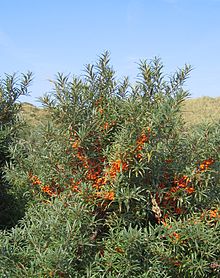Hippophae

Hippophae is the genus of sea buckthorns, deciduous shrubs in the family Elaeagnaceae. The name sea buckthorn may be hyphenated[1] to avoid confusion with the unrelated true buckthorns (Rhamnus, family Rhamnaceae). It is also referred to as sandthorn, sallowthorn,[2] or seaberry.[3] It produces orange-yellow berries, which have been used over centuries as food, traditional medicine, and skin treatment in Mongolia, Russia, Ukraine, and northern Europe, which are its origin regions.[4]
It is an exceptionally hardy plant able to withstand winter temperatures as low as −43 °C (−45 °F).[4] Because Hippophae develops an aggressive and extensive root system, it is planted to inhibit soil erosion and is used in land reclamation for its nitrogen fixing properties, wildlife habitat, and soil enrichment.[5] Hippophae berries and leaves are manufactured into various human and animal food and skincare products.[4]
The shrubs reach 0.5–6 m (1 ft 8 in–19 ft 8 in) tall, rarely up to 10 metres (33 ft) in central Asia. The leaf arrangement can be alternate or opposite.[6]
Hippophae goniocarpa grows in mountainous regions in Nepal and China on mountain slopes, river banks, flood lands and valley terraces. The growth altitude is typically between 2650 and 3700 m. The species is divided into two distinct subspecies, H. goniocarpa subsp. litangensis and H. goniocarpa subsp. goniocarpa. H. goniocarpa subsp. litangensis differs from the typical subspecies by the young branchlets and the lower surface of leaves.[7] The Latin specific epithet goniocarpa refers to goniocarpus -a -um with angular fruits.[8]
Hippophae gyantsensis
Hippophae litangensis
Hippophae neurocarpa
Hippophae rhamnoides: Common sea buckthorn has dense and stiff branches, and are very thorny. The leaves are a distinct pale silvery-green, lanceolate, 3–8 cm (1–3 in) long, and less than 7 mm (1⁄4 in) broad. It is dioecious, with separate male and female plants. The male produces brownish flowers which produce wind-distributed pollen. The female plants produce orange berries 6–9 mm (1⁄4–3⁄8 in) in diameter, soft, juicy, and rich in oils. The roots distribute rapidly and extensively, providing a nonleguminous nitrogen fixation role in surrounding soils.
Hippophae salicifolia (willow-leaved sea buckthorn) is restricted to the Himalayas, to the south of the common sea buckthorn, growing at high altitudes in dry valleys; it differs from H. rhamnoides in having broader (to 10 mm (3⁄8 in)) and greener (less silvery) leaves, and yellow berries. A wild variant occurs in the same area, but at even higher altitudes in the alpine zone.[citation needed] It is a low shrub not growing taller than 1 m (3 ft 3 in) with small leaves 1–3 cm (1⁄2–1+1⁄4 in) long.[citation needed]
Hippophae tibetana
Hippophae × goniocarpa Y.S.Lian et al. ex Swenson & Bartish
